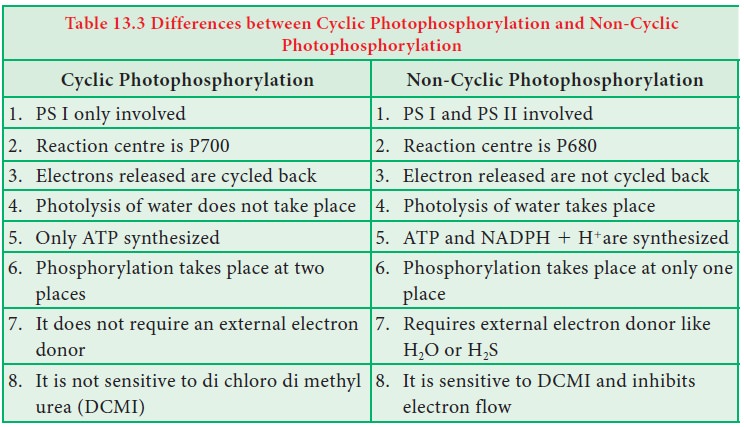Chapter: 11th Botany : Chapter 13 : Photosynthesis
Photophosphorylation
Photophosphorylation
Phosphorylation
taking place during respiration is called as oxidative phosphorylation and
ATP produced by the breakdown of
substrate is known as substrate level
phosphorylation. In this topic, we are going to learn about phosphorylation
taking place in chloroplast with the help of light. During the movement of
electrons through carrier molecules ATP and NADPH + H+ are produced.
Phosphorylation is the process of synthesis of ATP by the addition of inorganic
phosphate to ADP. The addition of phosphate here takes place with the help of
light generated electron and so it is called as photophosphorylation. It takes place in both cyclic and non-cyclic
electron transport.
1. Cyclic Photophosphorylation
Cyclic
photophosphorylation refers to the electrons ejected from the pigment system I
(Photosystem I) and again cycled back to the PS I. When the photons activate
P700 reaction centre photosystem II is activated. Electrons are raised to the
high energy level. The primary electron acceptor is Ferredoxin Reducing
Substance (FRS) which transfers electrons to Ferredoxin (Fd), Plastoquinone
(PQ), cytochrome b6-f complex, Plastocyanin (PC) and finally back to
chlorophyll P700 (PS I). During this movement of electrons Adenosine Di Phosphate
(ADP) is phosphorylated, by the addition of inorganic phosphate and generates
Adenosine Tri Phosphate (ATP). Cyclic electron transport produces only ATP and
there is no NADPH + H+ formation. At each step of electron
transport, electron loses potential energy and is used by the transport chain
to pump H+ ions across the thylakoid membrane. The proton gradient
triggers ATP formation in ATP synthase enzyme situated on the thylakoid
membrane. Photosystem I need light of longer wave length (> P700 nm). It
operates under low light intensity, less CO2 and under anaerobic
conditions which makes it considered as earlier in evolution (Figure 13.15).

2. Non-Cyclic Photophosphorylation
When
photons are activated reaction centre of pigment system II(P680), electrons are
moved to the high energy level. Electrons from high energy state passes through
series of electron carriers like pheophytin, plastoquinone, cytochrome complex,
plastocyanin and finally accepted by PS I (P700). During this movement of
electrons from PS II to PS I ATP is generated (Figure 13. 16). PS I (P700) is
activated by light, electrons are moved to high energy state and accepted by
electron acceptor molecule ferredoxin reducing Substance (FRS). During the downhill
movement through ferredoxin, electrons are transferred to NADP1 and reduced
into NADPH + H+ (H+ formed from splitting of water by
light).
Electrons
released from the photosystem II are not cycled back. It is used for the
reduction of NADP1 in to NADPH + H+. During the electron transport it generates
ATP and hence this type of photophosphorylation is called non-cyclic photophosphorylation. The electron flow looks like the appearance of letter ŌĆśZŌĆÖ and so known
as Z scheme. When there is
availability of NADP1 for reduction and when there is splitting of

Non-cyclic electron
transport PS I and PS II both are involved co-operatively to transport
electrons from water to NADP1 (Figure 13.6). In oxygenic species non-cyclic
electron transport takes place in three stages.

i. Electron transport from water to P680:
Splitting
of water molecule produce electrons, protons and oxygen. Electrons lost by the
PS II (P680) are replaced by electrons from splitting of water molecule.
ii. Electron transport from P680 to P700:
Electron
flow starts from P680 through a series of electron carrier molecules like
pheophytin, plastoquinone (PQ), cytochrome b6- f complex,
plastocyanin (PC) and finally reaches P700 (PS I).
iii. Electron transport from P700 to NADP1
PS
I(P700) is excited now and the electrons pass to high energy level. When
electron travels downhill through ferredoxin, NADP1 is reduced to NADPH + H+.
3. Bio energetics of light reaction
ŌĆó
To release one electron from pigment system it
requires two quanta of light.
ŌĆó
One quantum is used for transport of electron from
water to PS I.
ŌĆó
Second quantum is used for transport of electron
from PS I to NADP+
ŌĆó
Two electrons are required to generate one NADPH +
H+.
ŌĆó
During Non-Cyclic electron transport two NADPH + H+
are produced and it requires 4 electrons.
ŌĆó
Transportation of 4 electrons requires 8 quanta of
light.
Check your grasp!
Name the products produced from Non-Cyclic photophosphorylation?
Why does PS II require electrons from water?
Can you find the difference in the Pathway of electrons during
PS I and PS II?
Related Topics